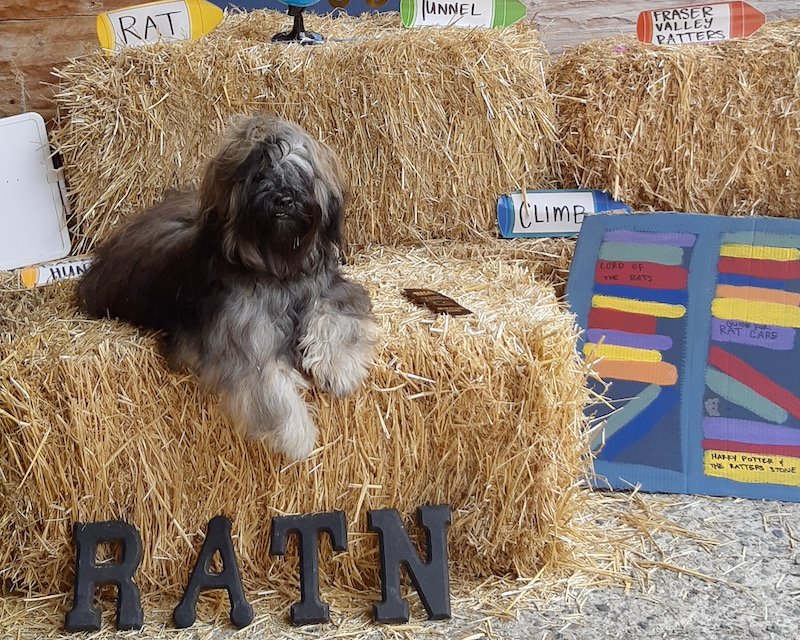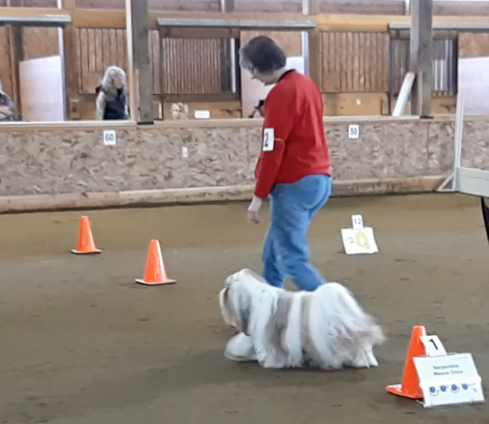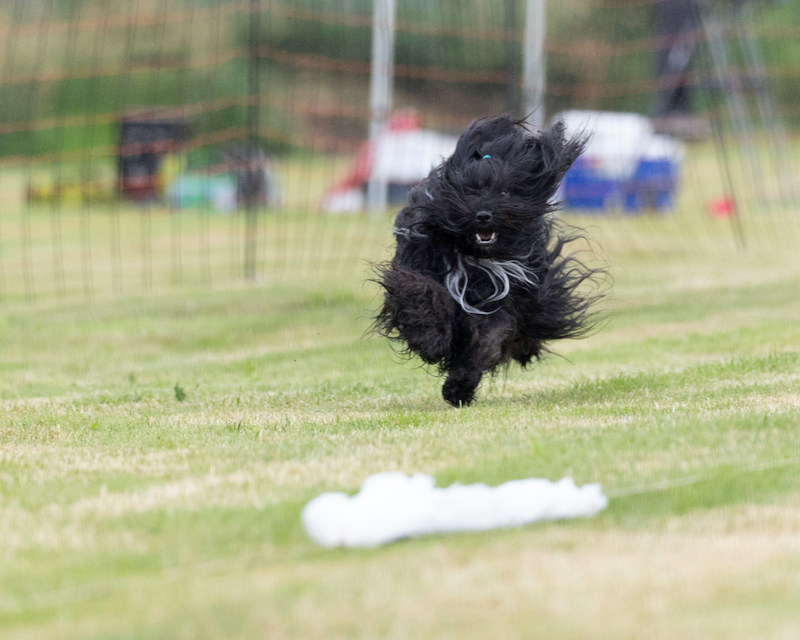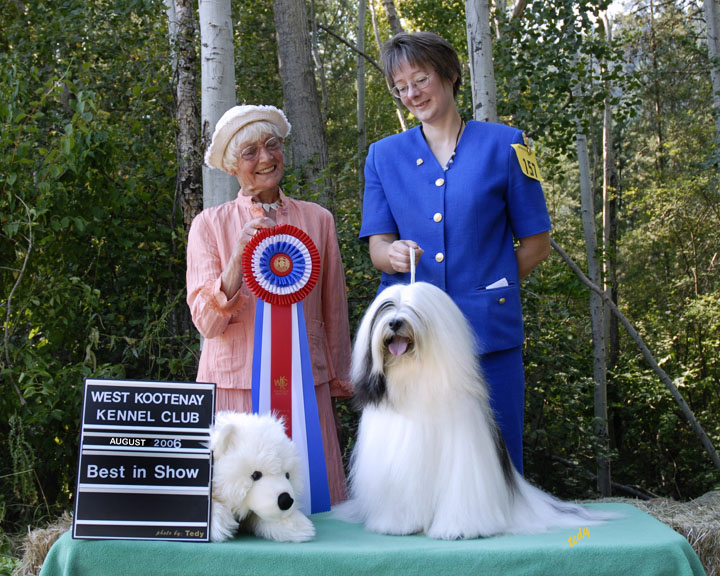Activities
One of the wonderful things about Tibetan Terriers is how versatile they are. While most of their time is spent as a family companion cuddling, playing with toys, going for walks or having a good chase around the yard, they also truly enjoy participating in many official dog sports.
Yes it is true some TTs are easier to train than others, and not every dog will be interested in every sport. The great thing is there are plenty to choose from! Want to show off how beautiful your dog is? Conformation shows are the answer. Obedience, Rally obedience and trick dog are the perfect venue to demonstrate how well your dog can perform various commands. Does your dog love to run and chase things? There's Chaseability and Sprinter for that! Scentwork and Barn Hunt have your dog using their nose. This also involves learning to read the sometimes subtle signals your dog is giving you when it finds what we are looking for. These are all activities we currently do or have done in the past with our dogs.
THIS PAGE IS STILL UNDER CONSTRUCTION...
Barn Hunt

Overview
Barn Hunt is a fun activity for dogs who like to sniff and search for things. In this sport they need to locate one or more rats (secured in a special tube designed for the rat's wellbeing) hidden in a course of straw bales. The courses also contain empty tubes and tubes with only rat litter, so the dogs must learn to discriminate between them. The courses become more complex as you progress through the levels. Only specially raised rats are used as they must be conditioned to the tubes and comfortable around dogs. There are rules that must be followed to ensure the safe handling of rats, ensuring they are not injured or stressed. Titles are awarded through Barn Hunt Association, and subsequently recognized by the Canadian Kennel Club.
Judging process
Dogs must wait their turn in small groups (usually 5 dogs) in an area called a blind. Although they wait in small groups they compete individually. They come into the ring on leash and must go to a "starting box" which is usually a 4'x4' mat. The handler must remove the dogs collar and leash and then release the dog once the judge says you can start. There is a set time limit based on the class entered. The time starts once the dog or handler leaves the starting box. The dog must correctly indicate the location of the rat(s) to the handler and also climb/jump onto the bales of straw and go through a tunnel within the the time limit in order to qualify.
Eligibility
Be individually registered with the Barn Hunt Association
Be 6 months of age or older
Spayed or neutered dogs may compete
Titles
There are a number of titles that can be earned starting with Instinct. Instinct (RATI) only requires one qualifying score. Three qualifying scores must be earned for each of the Novice (RATN), Open (RATO) and Senior (RATS) titles. Masters (RATM) requires five qualifying scores. There are a number of other titles including excellent and champion titles, plus non-regular classes that have different or additional requirements..
Rally Obedience

Overview
Rally Obedience is often referred to as just Rally. It is a more casual form of obedience that is fun for both dogs and handlers. The judge will prepare a course that contains between 10-20 skill-testing stations. Each station on the course has a sign that indicates what exercise must be performed. The exercises become more difficult as you progress through the levels. All exercises for Rally Novice and Rally Intermediate are performed with the dog on leash. All other levels are off leash. Handlers may talk to their dogs throughout the course.
Judging process
Prior to each class there is a walk-through where handlers get an advance look at the course without their dogs. Then each dog and handler team in the class will complete the course individually at their own pace. Rally is not scored with the same level of precision as obedience however judges will make deductions based on any faults they observe.
Eligibility
Be individually registered with the Canadian Kennel Club
Be 6 months of age or older
Spayed or neutered dogs may compete
Titles
In Canada there are a number of titles that can be earned starting with Rally Novice. In order to qualify a dog and handler must earn a minimum of 70 points on each course for Rally Novice (RN), Rally Intermediate (RI), Rally Advanced (RA) and Rally Excellent (RE) title. The Rally Master (RM) title requires a minimum of 85 points on a course. Three qualifying scores must be earned for each title.
There are also additional titles that require qualifying scores in multiple classes at the same trial. These are Rally Advanced Excellent (RAE), Rally Master Excellent (RMX), Rally Champion (RCH) and Rally Grand Champion (RGCH)
Sprinter

Overview
Sprinter is a fun activity for dogs who love to run and chase. The test is a 100-meter dash along a flat track. For safety reasons dogs are inspected when they arrive to ensure they are not lame or unfit to participate.
Judging process
As this is a timed event, there is no actual judging involved. Dogs run alone on the track chasing a lure which is usually a plastic bag attached to a lure machine. They must run the entire distance and cross the finish line in under 60 seconds to earn a qualifying run.
Eligibility
Be individually registered with the Canadian Kennel Club
Be 12 months of age or older
Spayed or neutered dogs may compete
Titles
Titles are earned by accumulating points. The time it takes for a dog to cross the finish finish line is converted to kilometers per hour. This is then multiplied by a handicap based on their height to calculate their points earned. Titles earned go at the end of a dog’s registered name.
Novice Sprinter (NS) = 150 points
Sprinter (S) = 500 points
Advanced Sprinter (AS) = 1,000 points
Sprinter Excellent (SX) = 1,500 points
Conformation

Overview
Conformation shows are often simply referred to as dog shows. Each breed has what is called a breed standard that defines what the perfect example of that breed should look and move like. Judges examine each dog both standing and moving and then select their winners based on their understanding and interpretation of the standard.
Breeds are divided into groups defined by the Canadian Kennel Club. There are seven groups: Sporting, Hounds, Working, Terriers, Toys, Non-Sporting and Herding. Tibetan Terriers are in the Non-Sporting group.
Judging process
Judging begins at the breed level where there are a number of different classes. Males and females are judged separately. The winner of each class competes for “Winners Male” and “Winners Female”. These winners then come back into the ring with dogs in the champion (Specials) class to compete for Best of Breed, Best of Opposite Sex, Select and Best of Winners.
The best of breed winners then complete against the other breeds in their group. The judge select placements from First through Fourth. The winners of each group then compete for the top honour of Best in Show and Reserve Best in Show.
Eligibility
Be individually registered with the Canadian Kennel Club
Be 6 months of age or older (there is also an unofficial baby puppy class for puppies age 4-6 months)
Must be intact although some shows do have classes for altered dogs.
Tibetan Terriers are shown naturally so must not be trimmed or clipped.
Titles
In Canada there are a number of titles that can be earned starting with Champion. To become a champion a dog must earn a total 10 points including a 2-point win. These points must be awarded by at least three different judges. The number of points earned is based on how many dogs were competing. Championship points can be earned at either the breed level or the group level. A dog can earn a maximum of five points per show.
The next title is Grand Champion where a dog must compete in the Specials class. They must earn at total of 20 points including two 2-point wins. In July 2021 the Canadian Kennel Club launched the Grand Champion Bronze (50 points), Grand Champion Silver (100 points) and Grand Champion Gold (200 points) titles. They also modified the previous Grand Champion Excellent title. Dogs that were already accumulating wins towards their Grand Champion Excellent title have until July 2022 to earn the title based on the old criteria.
Grand Champion Excellent requires a dog to first earn the Grand Champion title. They then need 100 points based on the schedule below, Best in Show or Best in National Specialty Show (where at least 10 dogs competed), three Group Firsts, plus a qualifying performance title.
Best of Breed (with minimum 5 dogs competing at breed level) 1 point
Best In Show or Best in National Specialty 10 points
1st in Group 5 points
2nd in Group 4 points
3rd in Group 3 points
4th in Group 2 points

